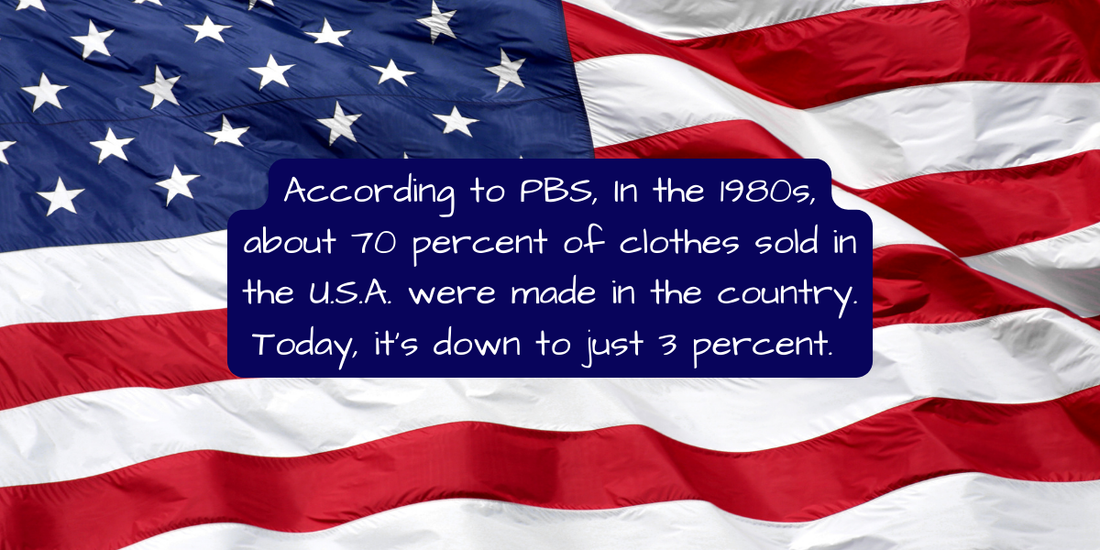
What Happened To "Made In America"?
Share
In the 1980s, approximately 70% of clothing sold in the United States was manufactured domestically. Today, that figure has plummeted to around 3% . This dramatic decline reflects significant shifts in global trade dynamics, labor costs, and consumer preferences over the past four decades. That is a staggering reduction.
The Shift from Domestic to Overseas Production
Several factors have caused manufacturing to go from the U.S. to other countries:
-
Globalization and Trade Policies: The expansion of global trade agreements and the entry of countries like China into the World Trade Organization made it economically advantageous for companies to outsource production to nations with lower labor costs.
-
Technological Advancements: Improved logistics and communication technologies facilitated more efficient international supply chains, making overseas manufacturing more feasible and attractive.
-
Consumer Demand for Affordable Apparel: The rise of fast fashion and consumer desire for inexpensive clothing led retailers to seek cost-effective production methods, often found overseas. According to earth.org "The (fast fashion) industry dries up water sources and pollutes rivers and streams, while 85% of all textiles go to dumps each year. Even washing clothes releases 500,000 tons of microfibres into the ocean each year, the equivalent of 50 billion plastic bottles."
Impact on the U.S. Textile Industry
The decline in domestic clothing manufacturing had profound effects on the U.S. textile industry:
-
Job Losses: Employment in the textile and apparel sectors decreased significantly. For instance, between 1979 and 2019, the apparel and textile industries lost 81% of their jobs, dropping from 2.2 million to 334,000 .Bureau of Labor Statistics
-
Factory Closures: Many manufacturing plants, especially in regions like the Rust Belt, shut down due to the inability to compete with lower-cost international producers.AllAmerican.org
The Importance of Supporting Domestic Manufacturing
Revitalizing American clothing manufacturing is crucial for several reasons:
-
Economic Stability: Domestic production supports local economies and job creation. This means it helps your neighbors get jobs.
-
Quality Assurance: Products made in the U.S. often adhere to higher quality and labor standards. For example, our alpaca products aren’t just warm—they’re made to last. We focus on quality, comfort, and craftsmanship, so you can count on every item to feel as good as it looks, season after season.
-
Environmental Considerations: Local manufacturing can reduce the carbon footprint associated with long-distance shipping. For our company, it allows us to help not only the environment but also supports American farms and manufacturers. Plus, we only ship in the United States which further lowers the carbon footprint of our products.
Conclusion
Back in the 1980s, about 70% of clothing sold in the U.S. was made right here at home. Today, that number is closer to 3%. It’s a big change—and a good reminder of why choosing American-made matters. When you buy products made in the USA, you’re supporting local jobs, better quality, and more sustainable practices. It’s not just good for your closet—it’s good for the planet.
-
PBS via Facebook – Statistic about 70% of U.S. clothing being made domestically in the 1980s:
👉 PBS Facebook Post -
Cotton Inc. / Lifestyle Monitor – Data on job loss and manufacturing decline:
👉 Cotton Inc. Lifestyle Monitor – Made in the USA - https://www.bls.gov/opub/mlr/1997/08/art3full.pdf
- https://www.voguebusiness.com/story/companies/new-us-tariffs-throw-fashions-supply-chain-into-turmoil?utm_source=chatgpt.com
- https://www.theatlantic.com/ideas/archive/2024/03/america-domestic-apparel-production/677734/
- https://earth.org/fast-fashions-detrimental-effect-on-the-environment/
